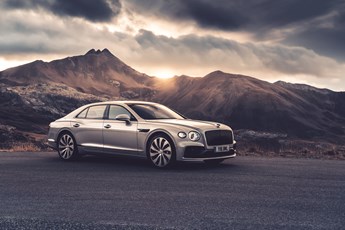
The start point for the best source of fleet information |
First drive: Bentley Flying Spur
Date: 24 December 2020 | Author: Simon Harris

|
|
||||||||||||||||
Most of our readers are unlikely to have Bentley on their choice lists. But there are a number of employees that have such vehicles as company cars.
I have had conversations in the past with fleet managers of financial institutions, and at boardroom level almost anything goes.
Whether we have any significant financial institutions left in the UK in the post-Brexit era remains to be seen, but while the Flying Spur (and other Bentleys) are currently only available with petrol engines, the luxury marque has plans to electrify its entire line-up over the next five years, and fully electric models are on the way.
So what's available now, reliant purely on petrol, gives us a good impression of what to expect not too far along the road. For example, the Flying Spur and the recently updated Bentayga SUV are both expected to be available with plug-in hybrid power in 2021, the former for the first time.
Our drive took place before the launch of the Flying Spur V8, so we tried the 6.0-litre W12 engine. The third-generation Flying Spur packs a great deal of technology to deliver Bentley's vision of supreme luxury alongside unrivalled driver engagement for a luxury saloon.
And since Bentley's flagship saloon, the Mulsanne, is now out of production, the Flying Spur has been developed to serve customers of both.
Its wheelbase is 130mm longer than the previous Flying Spur, with the front wheels pushed closer to the front of the chassis. This means much of the engine now sits behind the front axle, giving the Flying Spur better balance.
Another feature that helps make the Flying Spur feel rather smaller than its 5.3m length is four-wheel steering - a first for the brand. I was also surprised that our test car, fitted with 22in wheels in the Mulliner Specification (rather than the standard 21in wheels on the W12), rode very comfortably indeed.
The Flying Spur has sophisticated air suspension, as well as the option for the driver to select different driving modes. Even in comfort mode the Flying Spur deals with twisty roads with more decorum and elegance than any 2.5t car should.
Sport mode sharpens the car's responses, but the price of more resistance to rollwhen cornering is feeling every ripple and bump in the road surface from the 22in wheels.
The cabin is a combination of modern design and traditional materials, with choices of various wood veneer for the dashboard and doors, machined and chromed metal for some of the controls, and a digital instrument panel plus large centre screen on the dashboard.
Customers can also choose from a number of option packs, given the 'Specification' label, which cluster together related items. One stand-alone option is a mechanism that can rotate the dashboard screen to a set of dials, or if you prefer something more discrete, a plain panel that matches the interior trim. It's almost £5,000, but it's such a party trick I can't imagine any typical buyer not choosing it.
So, what about the downsides? The car is very expensive, and is projected to lose £100,000 to depreciation over three years/60,000 miles. We've seen lease rates from around £2,000 a month, which would work out much cheaper than buying outright. Maintenance too is rather more than, say, an Audi A8.
Fuel, of course, is also a substantial cost, but this, and BIK tax will be mitigated somewhat by the future plug-in hybrid.
The boot is no bigger in VDA volume than you'd find on a Mazda3 Fastback, although that doesn't mean it's tiny. And for some of the safety features you might expect as standard, such as adaptive cruise control, you have to pay extra for.
Bentley Flying Spur W12
P11D: £175,300
Residual value: 39.2%
Depreciation: £106,529
Fuel: £16,056
Service, maintenance and repair: £8,418
Cost per mile: 218.3p
Fuel consumption: 19.1mpg
CO2 (BIK band): 337g/km
BIK 20/40% a month: £1,081/£2,162
Boot space: 420 litres
Engine size/power: 5,998cc/635hp
Verdict |
8/10 |
|||
 |
|
 |
|
|










